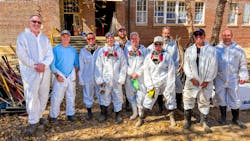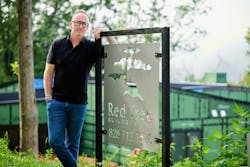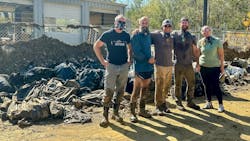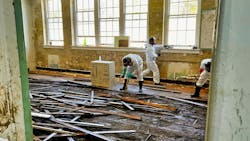Leading a Custom Building Business Post-Natural Disaster
Custom builder Brandon Bryant took his daughter to celebrate his Best of Asheville win on Friday, Sept. 27. The night brought together the vibrant Asheville community right on the Swannanoa River in Biltmore Village. When it began to drizzle, the two decided to head home. By the time they arrived, the rain intensified. Hurricane Helene began to make itself known.
Still, Bryant, owner of Red Tree Builders/Alair Asheville, recounts the hours before the category 4 hurricane hit Asheville, Black Mountain, and surrounding communities with feelings of surprise—an area seen as a climate refuge and a city filled with residents unprepared for a hurricane.
“My wife worked for FEMA for 15 years out of DC,” says Bryant. “She did some things, but even she didn’t fully prepare like she knows how."
Helene’s death toll reached 102 as of November 12, with fatalities mainly in Asheville and Black Mountain’s Buncombe County. Like many contractors within the hurricane’s path, Bryant’s been forced to find a balance between rebuilding his community, assisting his clients, running his business, paying his team members, keeping subcontractors close, and managing his own mental health amid the devastation post-hurricane.
The First Days Post-Hurricane Helene
A 3 a.m. wake-up call to ambulances after trees tore through his neighbor’s home still didn’t quite prepare Bryant. He spent hours watching trees go down, watching the clock go from 4 a.m. to 5 a.m. to 6 a.m.
“You can hear the wind like a train,” he recalls, still left with a sensitivity to loud sounds a month later.
One team member living on the Swannanoa River in Black Mountain texts that morning, “I think we’re taking on water. We going to have to evacuate.” Another sends a list of family’s phone numbers, “I love you guys.”
“It’s almost like she’s telling us goodbye,” says Bryant. Then cell service goes down. And power. More wind. Flooding. Mudslides.
Residents became detached from one another as the country watched videos of the unexpected devastation. The next day, Bryant went downtown. Bustling downtown sounds were replaced with helicopters, sirens, and chainsaws. He became one of 30 neighbors pushed upon the glass of the Asheville Museum of Science where they could access the internet.
“Then I saw the devastation. I sit there in tears, but in awe, and just glued to my phone,” says Bryant, who admits survivor’s guilt began to sink in.
Responding to the Hurricane
Major events like a hurricane can test the strength of a team. Thankfully, mental health is a large part of Red Tree Builders/Alair Asheville’s culture.
Bryant has been a vocal advocate for mental health awareness, not just with his team and peers, but sharing his experiences for the National Association of Home Builders’ mental health pilot program and industry publications.
That Monday, the team held a call for any who could join, and each member shared their experience and emotions thus far.
“I'm telling it was it was some of the most healing but like hard to digest,” says Bryant. “At this point, there’s a few people we hadn’t heard from ... I had to hide for a little bit. I don’t know if I could do this, I had to be strong for everybody but also vulnerable is who I am as a human. But I had to disconnect for a little bit and then I could bring myself back. I had to keep disconnecting because I just couldn’t keep digesting.”
The team sent out a newsletter with mental health tips and resources and Bryant shared his vulnerability on Instagram, and when ready, the team began with outreach to all past and current clients ensuring their safety, updating on build timelines, or identifying needs. Then expectations were set on severity, time, and resources, especially the team’s availability.
“And then what could I ask of the team and not push them too hard? Because I wanted us to respond, but also wanted to make sure people were comfortable going out and doing things,” says Bryant.
Bryant is the immediate past president of the North Carolina Home Builders Association and found incredible support from the local builder community. The association approved funds and began raising more, also matching all donations up to $100,000.
Advice from the Builder Community
Bryant reached out to other builders within the National Association of Home Builders who were more experienced with natural disasters, and they offered invaluable advice.
“That guidance and leadership helped us get to a better place quicker than if it had been just on me trying to figure it out, because I was not in good headspace,” says Bryant.
1. Your trades will want to return to work quicker than you think
It’s a reality that surprised Bryant, especially because five different subcontractors faced lost businesses, he says. One is now just a slab foundation. But they needed to begin building again to get their trades working again.
“One tidbit they gave me was, ‘You guys are going to have to build back as a home building industry. If you can get the trades back to work that’s good so they don't leave, or if they had devastation, help them because they're going to be part of the long term,’” says Bryant. “’This is a long game, Brandon. You'll see scars for years to come, but if those people leave or can't get back on their feet, this is going to even be more devastating.’”
2. Follow protocols for insurance work
One builder shared how he almost went out of business due to chasing insurance companies for payment. His warning to Bryant was although you’ll want to do everything to help the community, you can’t. Do free work if you’d like, but otherwise, go through the procedure. Let residents work with the insurance company, but don’t hurt your cash flow.
3. Take a deep breath and stay in your lane
Rather than attempt to start a nonprofit, start a new business model, or work on roofing or remodeling projects, Bryant was encouraged to stick to what he knew. This pushed him to go deeper into bridge building and discounted interior design services.
Building Back the Community
The Red Tree team couldn’t just go back to building luxury custom homes right away. Their worlds shifted, and while they felt powerless, they put their skills to good use, much like the rest of the community.
“A lot of the people in the community that we're out and about were people in construction,” says Bryant. “They had equipment, chainsaws, and know what they're doing. And I was seeing so many other builders and other people that work for me, it came to I was telling them, ‘You've got to take a day for yourself.’”
Each week, the Red Tree team volunteers together for some kind of rebuilding effort. So far, they’ve helped cleanup efforts in Marshall, NC, prepared meals with World Central Kitchen, and donated office supplies to Sugar Hollow Solar.
Bryant’s father owned a bridge building company, so he decided to partner up and expand offerings as a response to the hundreds of bridges demolished by the hurricane. When one team member expressed a strong pull for helping the community, Bryant suggested he assist in building bridges.
Bryant and his team continue to workshop various ideas to keep cash flow moving but to offer their valuable skills to the community. One of Red Tree’s designers suggested highly discounted rates to offer homeowners and other builders.
A Month Later
For Bryant, it feels like he’s been at a funeral for the past 30 days. When days become more normal, businesses begin to open up, and he sees another part of the city where devastation remains, but they continue to build bridges and look for ways to support the community.




